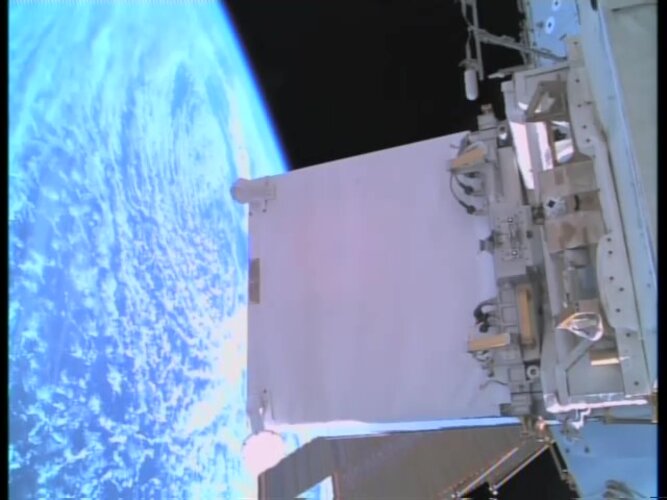
Copernical Team
China's Shenzhou-19 astronauts return to Earth
 Three Chinese astronauts returned to Earth on Wednesday after six months on the country's space station, state media footage showed, as Beijing advances towards its aim to become a major celestial power.
China has ploughed billions of dollars into its space programme in recent years in an effort to achieve what President Xi Jinping describes as the country's "space dream".
The world's se
Three Chinese astronauts returned to Earth on Wednesday after six months on the country's space station, state media footage showed, as Beijing advances towards its aim to become a major celestial power.
China has ploughed billions of dollars into its space programme in recent years in an effort to achieve what President Xi Jinping describes as the country's "space dream".
The world's se New analysis upends belief that asteroid Vesta has planetary interior
 For decades, scientists believed Vesta, one of the largest objects in our solar system's asteroid belt, wasn't just an asteroid. They concluded that Vesta has a crust, mantle and core - fundamental properties of a planet.
Astronomers studied it for clues to how early planets grew, and what Earth might have looked like in its infancy.
Now, Michigan State University has contributed to
For decades, scientists believed Vesta, one of the largest objects in our solar system's asteroid belt, wasn't just an asteroid. They concluded that Vesta has a crust, mantle and core - fundamental properties of a planet.
Astronomers studied it for clues to how early planets grew, and what Earth might have looked like in its infancy.
Now, Michigan State University has contributed to Amazon launches first Starlink-rival internet satellites
 Amazon on Monday launched its first batch of Project Kuiper internet satellites, marking the start of its push to rival Elon Musk's Starlink.
The mission, called Kuiper Atlas 1, lifted off from Cape Canaveral Space Force Station in Florida at 7:00 pm local time (2300 GMT), aboard a United Launch Alliance (ULA) Atlas V rocket that will carry 27 satellites into orbit.
A previous attempt wa
Amazon on Monday launched its first batch of Project Kuiper internet satellites, marking the start of its push to rival Elon Musk's Starlink.
The mission, called Kuiper Atlas 1, lifted off from Cape Canaveral Space Force Station in Florida at 7:00 pm local time (2300 GMT), aboard a United Launch Alliance (ULA) Atlas V rocket that will carry 27 satellites into orbit.
A previous attempt wa New Horizons creates first Lyman alpha map of the galactic sky
 The NASA New Horizons spacecraft's extensive observations of Lyman-alpha emissions have resulted in the first-ever map from the galaxy at this important ultraviolet wavelength, providing a new look at the galactic region surrounding our solar system. The findings are described in a new study authored by the SwRI-led New Horizons team.
"Understanding the Lyman-alpha background helps shed li
The NASA New Horizons spacecraft's extensive observations of Lyman-alpha emissions have resulted in the first-ever map from the galaxy at this important ultraviolet wavelength, providing a new look at the galactic region surrounding our solar system. The findings are described in a new study authored by the SwRI-led New Horizons team.
"Understanding the Lyman-alpha background helps shed li ACES finds its home in orbit

The Atomic Clock Ensemble in Space (ACES), ESA’s state-of-the-art timekeeping facility, has been successfully installed on the International Space Station, marking the start of a new chapter in space-based precision science.
Biomass poised for liftoff to unveil forest secrets

After years of careful design and preparation, ESA’s Earth Explorer Biomass satellite is set for launch tomorrow, 29 April at 11:15 CEST, aboard a Vega-C rocket from Europe’s Spaceport in French Guiana.
This groundbreaking mission will offer unprecedented insights into the state and evolution of the world’s forests. By mapping the woody material in Earth’s forests, this revolutionary satellite will play a crucial role in deepening our understanding of how forests influence the global carbon cycle.
ACES in space
 Image:
Image:
The Atomic Clock Ensemble in Space (ACES), ESA’s state-of-the-art timekeeping facility, is now installed on the Columbus laboratory of the International Space Station. This still image, captured by external cameras on the Station, shows ACES after installation. For 25 years, cameras on the Station have documented activities in orbit, providing real-time views of operations like this one – a rare and remarkable perspective from space.
On 25 April, the Canadian Space Agency’s robotic arm carefully extracted ACES from the SpaceX Dragon trunk and secured it onto the Columbus External Payload Facility, next to ESA’s space storm hunter ASIM
ESA’s Biomass mission launches on Vega-C
 Video:
00:02:01
Video:
00:02:01
ESA’s state-of-the-art Biomass satellite has launched aboard a Vega-C rocket from Europe’s Spaceport in French Guiana. The rocket lifted off on 29 April 2025 at 11:15 CEST (06:15 local time).
In orbit, this latest Earth Explorer mission will provide vital insights into the health and dynamics of the world’s forests, revealing how they are changing over time and, critically, enhancing our understanding of their role in the global carbon cycle. It is the first satellite to carry a fully polarimetric P-band synthetic aperture radar for interferometric imaging. Thanks to the long wavelength of P-band, around 70 cm, the
Biomass launched to count forest carbon

ESA’s groundbreaking Biomass satellite, designed to provide unprecedented insights into the world’s forests and their crucial role in Earth’s carbon cycle, has been launched. The satellite lifted off aboard a Vega-C rocket from Europe’s Spaceport in Kourou, French Guiana, on 29 April at 11:15 CEST (06:15 local time).
Gaia spots odd family of stars desperate to leave home


































